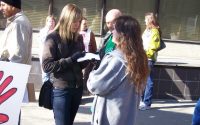The Key to Credibility: The Interview
By Nathaniel Trinidad Doherty
October 2, 2019
An essential tool that is never to be misused, the interview has been a strategy to contextualize and support news pieces since the dawn of the journalistic trade. Today, more than ever, it is important to use this powerful tool honestly and effectively in the ever-accessible media-scape.
In today’s modern, technologically oriented society, information is infinitely accessible at the snap of a finger. Because there is now an abundance of news outlets/sources that can be found wherever there is an accessible screen, it is never enough to expect an audience to “take your word for it” in a journalistic piece. Journalists must provide supporting evidence to substantiate their claims, one of the most common forms being the interview. To make things slightly more complicated, it isn’t enough to just conduct an interview; it has to be done right.
When planning out an interview, Bob Wyss, insists it is essential to note that “building trust (between interviewer and interviewee) is paramount” (2019, 72). According to Bob Wyss, this is achieved, first, by providing the interviewee with some form of valid identification. Next, the interviewer must be perfectly transparent about the “purpose of the interview and the plans for the story” (2019, 73).
Also incredibly important to the development of a good rapport is the setting of the interview. Initial interviews should always be done in person so the two parties can get well acquainted. Telephone interviews are never optimal but can be effective after a level of trust has been reached. “Keep away from email interviews unless there is absolutely no other way of obtaining the information” (2019, 73).
Finally, interviewer’s job is to listen and ask good questions. Bob Wyss says that it is good to ask open-ended questions and to let gaps of silence ride out (2019, 75). In turn, this allows the interviewee to answer the initial question and then also to have a moment of silent reflection where they may add more details to their initial response. Terry Gross (Figure 1) from NPR’s Fresh Air sets a great example of how to extract extra details from those she interviews. “She coaxes the most revealing content out of her subjects, by adopting a very personal uncaptioned rapport and asking questions” (Israel 2012).

The aspiring journalist should strive to follow Terry Gross’s example. Build a rapport, be transparent, and make the interviewee WANT to tell you more than he/she has been asked.
Sources:
Wyss, Bob. Covering the Environment: How Journalists Work the Green Beat.New York:Routledge, 2019. Print. pp. 72–78.
Israel, Shel. 2012, April 19, “9 Tips on Conducting Great Interviews.” Forbes, Forbes Magazine. Online access: https://www.forbes.com/sites/shelisrael/2012/04/14/8-tips-on-conducting-great-interviews/ – 646199bc56f1

